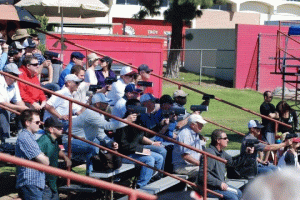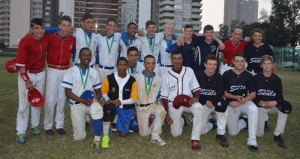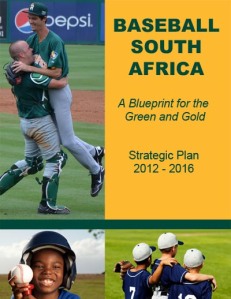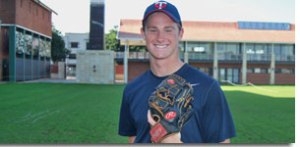(Although this article was aimed at the high school baseball prospect, the message is applicable across all forms of the game)

Your try out for the freshman baseball team is a job interview. Your performance at high school, at least until you play for the varsity team, may be relatively unimportant in the overall college recruiting picture however not making your freshman baseball team could be a death knell to your chances of playing at the next level. If you don’t make your high school team as a freshman, your options become extremely limited. There are other options like Spring League but your likelihood of making one of those rosters is miniscule if you can’t make your freshman team. Your best path to a college baseball scholarship, for anyone other than the very elite, is through the Freshman-JV-Varsity team route, not necessarily in that order. This makes your initial tryout extremely important.
I overheard a high school freshman baseball coach at a top baseball school say the following about tryouts;
“We are looking for two things at the tryout, a reason to cut you or a reason to keep you.”
Preparation
If you finish playing youth baseball in June and high school tryouts are scheduled for December or January, don’t expect the coaches to take into account whether you are “rusty” or “out-of-season”. You will be expected to keep yourself in baseball shape for the tryouts. And that means being able to do drills, throw and play every day for up to a week. It’s a good idea to reach out to the high school coach months prior to the tryout. Ask his advice on what camps or clinics to attend and what you can do to best prepare. Aside from providing the coach with familiarity it shows that you are willing to work on your own to bridge the delta between youth baseball and high school ball and give them a reason to keep you.
As simple as it may sound, you need to play as much baseball as you can before you get to high school. Baseball is not just about talent, it’s about repetitions. The more reps you have under your belt, whether it be swinging the bat, throwing the ball, taking grounders or fielding fly balls, the better prepared you will be to play high school ball. The better the competition you play against, the better the preparation.
Make sure you are on some kind of throwing program long before you try out. Throw long toss to prepare your arm. Whether you were the youth baseball shortstop of the year or all league third base, you will be evaluated in more than one position during tryouts. Expect to be throwing from the outfield even if you have never played that position. Expect to throw more during that week than you have in months. Coaches are on the lookout for arm strength because it is an integral part of baseball, in any position. If you have arm strength (and speed) coaches believe they can teach the rest. If your arm is tired after day one because all you did over the summer was play “Call of Duty”, you have given them a reason to cut you.
The Look Test
Look the part! It’s a baseball tryout, arrive looking like a baseball player! That means proper baseball pants with a belt and your baseball top neatly tucked in, clean cleats and a baseball cap. The cap should not be tipped back on your head or worn backwards. If at all possible, wear generic items. Keep the logos to a minimum. The coaches are not really going to care if you support the Boston Red Sox, in fact one of them may hate the Sox. Neither do they care if you played on a particular travel ball team or were a Little League All Star. If they never saw you do it, it never happened. Avoid anything that might detract from your performance. If possible, wear a jersey with your name on the back to make it easier for coaches to distinguish you from the rest.
Your peers might really like your two glistening diamond earrings; your ability to keep your pants hanging below your behind without falling off; your “I’m a bad-ass” wife-beater with the image of the latest anti-establishment teen band or your trucker cap worn askew over your long stringy hair, but this screams to the coaches that you are an uncoachable individual trying out for a team sport and it’s a reason to cut you.
First Impressions
The first impression during a baseball tryout is vital. Get there early and eagerly (you can bet that coaches will be watching you arrive). If you really don’t want to be there and are being coerced by your parents to play baseball, do everyone a favor and find an activity that you really do care about. If you are watching the clock, you probably don’t have the commitment that coaches are looking for or that you will need to succeed. Maintain eye contact with the coaches as they explain the drills and then hustle between stations. Not only are coaches evaluating your ability, they are also keenly watching your effort. If two players are of roughly equal ability they will then look for a reason to keep one over the other. This is the time to disregard the peer pressure to conform to the mediocrity of the majority. This is no time to be timid. Give your best effort, hustle everywhere and go out of your way to be helpful. And above all else, be nice! You are very likely to be tense and focused but force yourself to be relaxed and friendly. Not only will you perform better but you may give the coaches a reason to keep you.
Skills
No matter where you are exhibiting your skills, coaches are looking for similar things. Your overall athletic ability which includes your overall strength and your ability to move and run. They look at your baseball ability which includes your throwing, catching, hitting and the ability to make the routine play. Your unique ability to emulate the style of a particular Major League player while flashing the glove at shortstop is not going to help your cause. The rule is going to be less flash and more substance. They will look at your coachability. You need to be able to take instruction well and at least try and do what is being asked of you without questioning the reason. This necessitates that you display a trust in the coaches despite your conviction that your way would probably be better. Show some hustle. It does not take talent to hustle. Be the first to volunteer to help get equipment out or put away. Don’t concern yourself with how your peers perceive you, they are a competing for your position and your hustle might just be the reason to keep you.
As you partner up and hustle out into the outfield to throw for the first time on the first day of tryouts, you will be watched. Take it seriously – you play like you practice. This is not the time to catch up with your buddies and share summer war stories. Warm up properly and hustle from the first throw. You are expected, at the very least, to have mastered the basics before you get to high school. If you have bad throwing mechanics, you are going to stand out. With bad mechanics, unless you can throw in the high eighties and are infinitely coachable, you are giving them a reason to cut you.
High school coaches are generally looking to put together a team of the best components that will help them win baseball games. If you are looking for individual coaching on the basic fundamentals of baseball, you are in the wrong place. That does not mean that you are expected to be flawless. Coaches will consider taking a chance on you if you arrive with a strong foundation albeit marred by minor flaws. In this instance, if you take direction well and indicate a willingness to work in your own time to eradicate the problem, coaches will find a reason to keep you.
The Drills
Do it right, even when you think nobody is watching you. When you jog to warm up be in front of the pack. When you stretch be the best. When you play catch, repeat good mechanics, throw to a target and hit it every time. When you play catch, catch the ball or block the bad throw and keep it in front of you every time. When you are doing a drill, focus on doing it right, every time. Hustle all the time. Never walk on a baseball practice field. Sprint out to your position every time whether it’s the first or last inning. As a batter/runner run to first as though it matters whether you are safe. Know the situation on defense and do the right things. Trust the coach and give maximum effort to every task you are being taught. Coaches will believe that what you show at the tryouts is the very best you have, and it should be. If you don’t understand ask – there is nothing worse than repeating the same error time and time again because you did not understand the drill. Don’t let this perceived inability to do a drill correctly be a reason to cut you.
The Expectations
Outfielder expectations. During the try outs, you are likely to catch fly balls and then make throws to 2nd, 3rd base and home. A radar gun will probably measure your velocity but coaches are going to be looking at your ability to hit the target with a throw rather than a high velocity throw that hits halfway up the backstop. If you have a strong arm, it will be noticed, but your inability to control it will be considered a liability. In the outfield coaches are also looking for your ability to judge fly balls and how smoothly you get into position to catch and make a throw and how you field a ball on the ground while on the run.
Infielders expectations. You will receive a series of ground balls (at you, to your right, to your left and slow rollers) and be expected to field them cleanly and make an accurate throw to first base. Again you might see a radar gun measuring velocity and arm strength but these attributes are irrelevant if your throw ends up in the dugout. More important is your ability to field ground balls, your athleticism, the speed with which you get the ball out of your hand and the accuracy of the throw. Infielders must also know the basic cut-off plays and be able to turn quick relays.
First Basemen will be expected to receive balls from both the infield, outfield and pitcher; know your position during throws home and make strong accurate throws to third base. You will also be evaluated on your ability to block the errant throw and keep the ball in front of you.
Catcher pop times will be recorded. That’s a glove to glove stopwatch time on throws to second base from a crouched position behind the plate. They are looking for timing and accuracy. You will also be behind the plate during the hitting and pitching tryouts to judge your ability to receive pitches and block the ball in the dirt. Catchers are expected to direct the traffic because they in a unique position to see the entire field. Don’t be afraid to be vocal during your try out.
High school coaches are always looking for pitchers. The focus is on good mechanics; location, location, location; ball movement; change of speeds; velocity and above all mental toughness. High school pitchers should be able to shorten the leads of base runners and stop walking leads by sporting an effective pick-off move to all three bases. Pitchers must also be able to field their position, cover home on a passed ball, back up third base or home on throws from the outfield and cover first on balls hit to the right side of the infield.
Coaches look for two things with hitting. Can you hit for power and can you hit for average. Hitting for average is the ability to hit any pitch from right- or left-handed pitchers to anywhere on the field, and hitting for power is the ability to hit for extra bases. The combination of power and average allows versatility within the batting lineup to maximize offensive production.
When hitting, whether you touch the ball or not, do you exhibit swing mechanics that show that you have the ability to be a potential hitter? Did I mention that coaches believe they can teach everything other than arm strength and speed. By the time you reach high school, you are expected to exhibit bat control. You should be able to drive a pitch on the outer half of the plate to opposite field. High school coaches emphasize hitting “behind” a runner at first or second base in order to move him over into better scoring position. Despite the fact that you never bunted in youth baseball because you were the number three hitter, you are going to be expected to lay down a sacrifice bunt in high school, and be willing to give yourself up for the sake of the team. You need to know and understand the difference between a sacrifice, an attempted bunt for a base hit and the game situations for using each technique. Be selective at the plate and swing only at strikes. Hitters must be patient enough to wait for a quality pitch to swing at, recognize the pitch and be able to capitalize on the opportunity when you get “your” pitch. Strive to hit every pitch either back up the middle or to the opposite field and hit high percentage line drives. Be as good at taking bad pitches as you are at hitting good pitches!
The Reward
If you are lucky enough to be selected for your high school Freshman baseball team, you have beaten the odds. Now you have a roughly 6% chance of playing NCAA College Baseball. On a high school team with a roster of twenty players, that’s 1.2 players that will go on to play college ball. You have to truly believe that you are one of those players if you are to have any hope of succeeding. You are embarking on a heady journey with a very enticing destination. What may seem like a long time will accelerate and if you don’t constantly stop and take stock, you might miss out on the opportunity of a lifetime. You will have to make sacrifices to achieve your goals. While your classmates are out partying, you may be working out. Perhaps you will miss a social event because you were in a tournament or playing in a showcase but the reality is that the enrichment you and others on your journey are receiving while participating in these athletic contests provides ample compensation. Before you know it, you will be faced with the enticing choice of playing professional ball or accepting a D1 baseball scholarship. That seems like a good reason not to be cut.
Wayne Williams, D1Prospect.com





